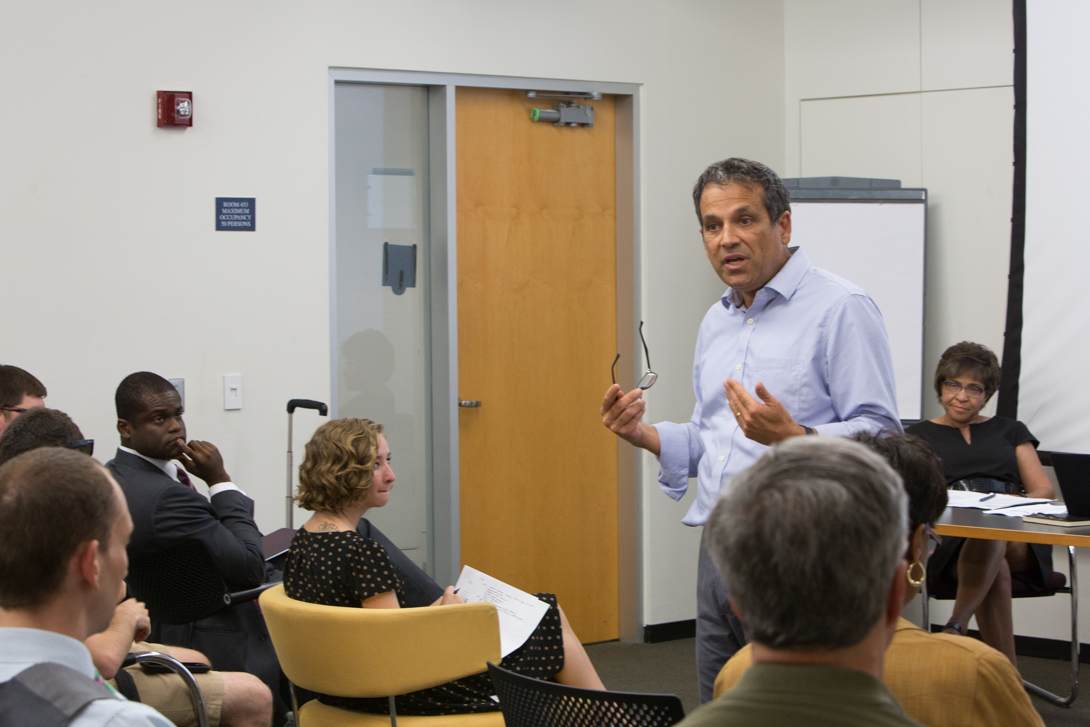Provost Forrest Maltzman and Deputy Vice President and Treasurer Ann McCorvey explained the decision-making behind recent departmental reorganizations, took questions and expressed optimism about the George Washington University’s financial future at a staff-organized town hall meeting Wednesday evening.
The meeting focused on GW’s budget and financial strategies.
“One of the things we want is for these decisions to be as transparent as possible,” Dr. Maltzman said.
He said the higher education landscape has “changed drastically” in recent years and called it a “challenging time” for many institutions.
In past years, Dr. Maltzman said, many schools—including GW—innovated by relying upon “fairly aggressive pricing” and increased enrollment to grow their budgets.
But family incomes have become stagnant and changing demographics have made the higher education landscape more competitive. As a result, the need for financial aid continues to rise at a rate higher than inflation.
“We can’t keep raising expenses on our families at the rates at one point in time we and the rest of the market did, and we can’t count on enrollment growth in a way we were once able to do,” Ms. McCorvey elaborated.
In the future, higher education is going to need to rely upon reallocation as the primary vehicle for sustaining innovation, Dr. Maltzman explained. “None of us want to work at an institution that does not innovate. But we can’t do it on the backs of enrollment growth and aggressive pricing.”
As a result, Dr. Maltzman said it would be “disingenuous” to commit to no additional layoffs.
Ms. McCorvey explained that GW has two main sources of income: the revenue it receives and the payout from the school’s endowment.
When revenue stalled during the 2008 recession, she said, the university made a decision to invest in student financial aid so the burden of paying for college would not fall disproportionately on the families of students in need.
In order to do so, it drew on money from its reserves, which Ms. McCorvey analogized to a kind of institutional savings account.
Over the next few years, however, costs continued to grow faster than revenue did.
“[Now] we want to start putting money into savings,” Ms. McCorvey said. “We want to manage costs, then begin to save for our future and invest in new strategies.”
Dr. Maltzman and Ms. McCorvey stressed the difficulty involved in deciding to eliminate positions or reallocate resources. Ms. McCorvey said she has made a point of showing appreciation for staff members who have had to take on additional responsibilities.
“I’m very hopeful that… we have been extremely mindful to do it in such a way as to minimize the impact upon students and faculty research…and, as much as possible, to [take advantage] of efficiencies in the system,” Dr. Maltzman asserted.
At the same time, he acknowledged that the staffing changes, along with increased enrollment, have required those who work at the university to make an extra effort.
Both administrators said some of the most effective strategies for ensuring resources are spent on highest priorities could come from staff.
“We need engagement [from staff],” Ms. McCorvey said. “Each department, each process, each function is going to have to step back and say, ‘What in this new higher ed environment can I modify that has the most positive outcome?’”
As additional vehicles for ensuring staff input, Dr. Maltzman suggested that staff join Faculty Senate committees. He said the administration would continue to put staff on key committees, as it has done with the Benefits Advisory Committee, the Benefits Task Force, the Access and Success Committee and the strategic plan working groups.
Although he did not think it was appropriate for staff to form an organization analogous to the Faculty Senate, he said that staff could create their own organization as students have done with the Student Association.
In spite of the challenges, Dr. Maltzman said he was “bullish” about GW’s future in a difficult market.
“This is the heyday of urban education,” he said, pointing out that GW’s location and increasing research portfolio make it attractive to researchers and students.
He also said graduate applications for GW’s on-campus programs are up 5 percent from last year and deposits are up 2.4 percent.
GW’s operating budget for FY 2017 is available on the Budget Office website.


